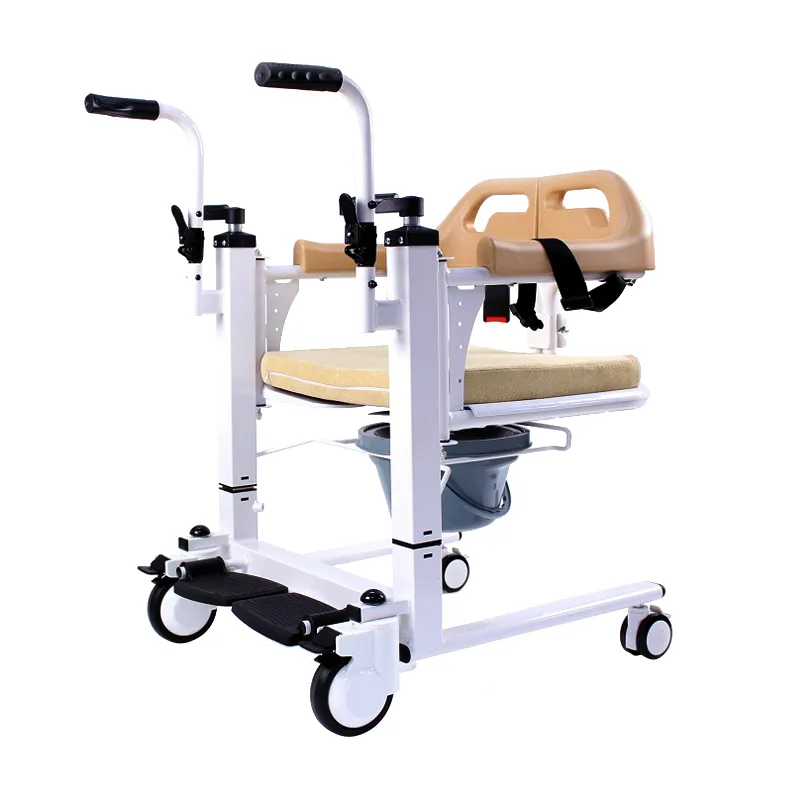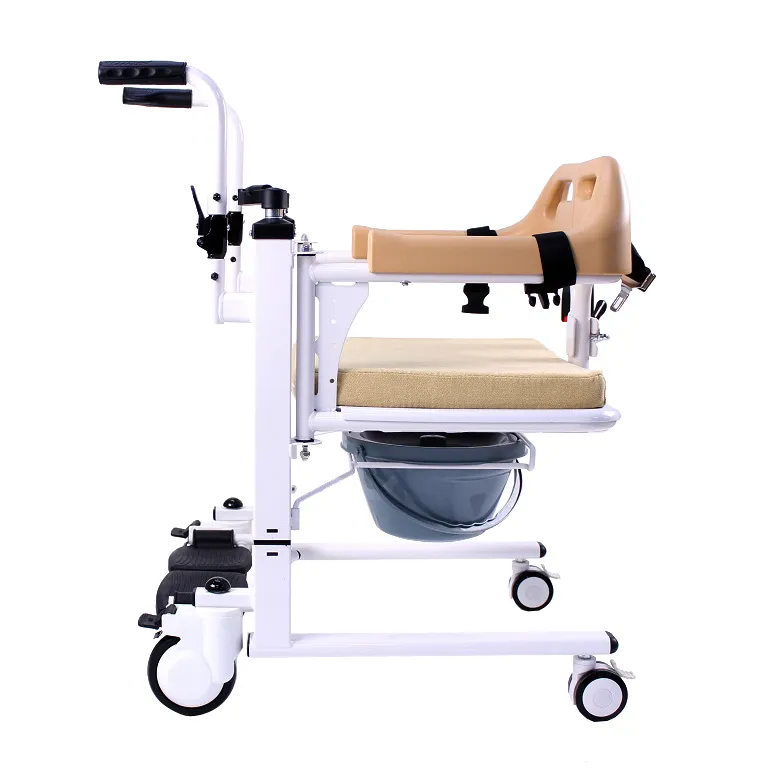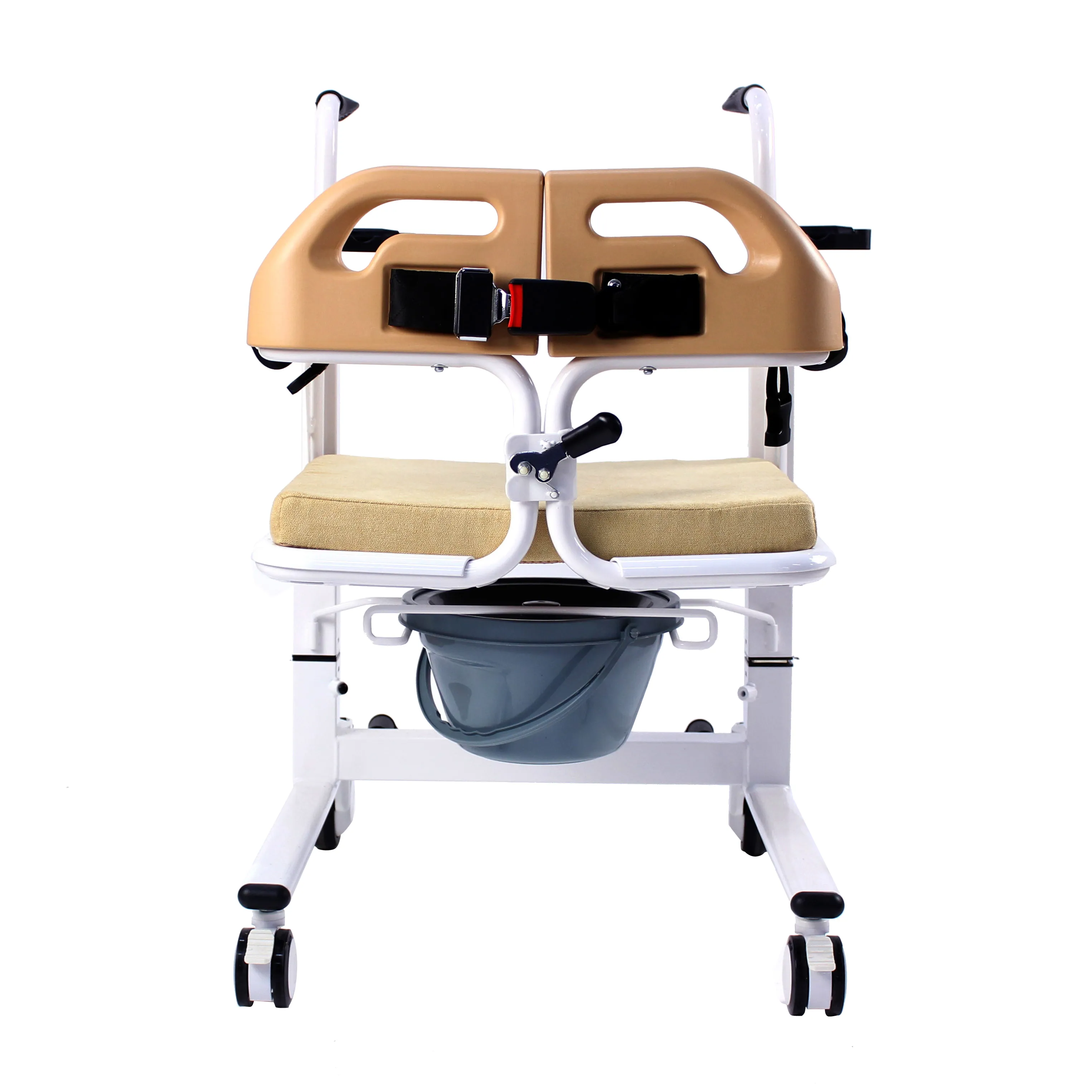Among various medical care devices, the patient lift transfer chair, with its multiple advantages, including lifting, transfer, bathing, and toileting functions, is becoming an increasingly important component in hospitals, nursing homes, and even homes.
With the increasing diversity of individual patients, especially the increasing number of obese and elderly people with disabilities, a critical question has become: How much weight can a patient lift transfer chair handle? This not only affects the lifespan and safety of the device itself, but also the safety of patients during transfers, and even involves the operational risks and responsibilities of caregivers.
This article will delve into this question from multiple perspectives: structural principles, load-bearing standards, load limits of common models, safety margin analysis, purchasing considerations, and international certification standards, comprehensively addressing this core question concerning the "bottom line" of usage.

What is the purpose of a patient lift transfer chair?
The patient lift transfer chair is a multifunctional nursing device designed specifically for patients with limited mobility or complete disability. Its main functions include:
· Assisting patients in smooth transfers between beds, wheelchairs, toilets, and bath chairs;
· Reducing the burden on caregivers and preventing injuries from manual handling;
· Reducing the risk of falls, fractures, and slips;
· Improving transfer efficiency and a more dignified experience.
The patient lift transfer chair is widely used in:
· Hospitals (internal medicine, rehabilitation, and ICUs);
· Elderly care facilities;
· Post-traumatic rehabilitation centers;
· Home care settings
What factors affect the load-bearing capacity of a patient lift transfer chair?
The maximum load capacity of a patient lift transfer chair isn't arbitrarily set; it's based on several structural and technical factors:
1. Main Frame Material
· Carbon steel structure: Low cost but heavy, typically with a load capacity between 120–150 kg;
· Aviation aluminum alloy: Lightweight design, strong corrosion resistance, typically with a load capacity of 150–180 kg;
· Titanium alloy/heavy-duty steel: Used in heavy-duty reinforced versions, with a load capacity of over 250 kg;
· Stainless steel structure: Commonly used in equipment used in wet areas (such as showers), with a combined load capacity of 140–180 kg.
2. Lifting System Design
· Hydraulic pump: Commonly found in mid- and low-end products, with minimal load pressure fluctuation and a maximum load capacity of approximately 150–180 kg;
· Electric actuator motor: High-performance products use electric lift, with higher rated loads, some exceeding 200 kg;
· Dual-motor system: Used for heavy-duty care, ensuring synchronous lifting in both directions, and with a greater load capacity than single-motor systems.
3. Chassis Width and Axle Bending Strength
A wider chassis provides better structural stability. Whether the axle is designed with a compression-resistant material (such as industrial rubber with a steel core) determines whether the device will tilt or become unbalanced when loaded.

Load-bearing data for mainstream patient lift transfer chairs on the market
To verify the load-bearing capacity of patient lift transfer chairs in actual use, we collected parameters for mainstream products from over 10 well-known manufacturers in countries such as the United States, Germany, and China. These are shown in the table below:
Brand/Model | Country | Load Capacity (kg) | Lifting Method | Notes |
| Joerns Hoyer Advance | United States | 155 kg | Hydraulic | Portable and foldable, suitable for medium-sized patients |
| Invacare Reliant 350 | United States | 160 kg | Electric Actuator | Commonly used in hospitals, comes with batteries and a remote control |
| Guldmann GH3 | Denmark | 200 kg | Electric Boom | Suitable for critically ill patients, can be suspended from a ceiling rail |
| Drive Medical TL4500 | United States | 180 kg | Manual Hydraulic | Usable for both home and institutional use |
| Molift Smart 150 | Norway | 150 kg | Electric Portable | Foldable and portable design, perfect for travel care |
| Dayang Medical DY077600-46 | China | 100 kg | Hydraulic | Designed specifically for critically ill patients, with a reinforced steel chassis |
As shown in the table, the average load-bearing range for mainstream patient lift transfer chairs is between 100–180 kg. Heavy-duty models designed for obese or special needs patients can reach loads as high as 200 kg.
Load Capacity of Patient Lift Transfer Chairs: International Standards and Regulations
The load capacity of a patient lift transfer chair is not a manufacturer's arbitrary labeling; it must comply with the following international standards:
✅ US FDA Certification (DME Equipment Standard)
As part of DME (Durable Medical Equipment), the FDA requires that the structural strength of a patient lift transfer chair meet a safety margin factor of at least 1.5 times. This means that a product with a rated load capacity of 150 kg must support 225 kg without deformation.
✅ European CE Certification
EN 12182: General Standard for the Safety of Assistive Devices for People with Disabilities requires that lifts exhibit zero structural fatigue damage after 25,000 lift cycles.
✅ ISO 10535 International Standard
Specific to patient transfer equipment, including patient lift transfer chairs, it specifies that they must be able to support the combined force of the user and caregiver and be equipped with devices to prevent slipping and tipping.
What are the risks of overloading a patient lift transfer chair?
Even if some models are rated to carry over 200 kg, a safety margin must be maintained during use. The following are typical risks associated with overloading:
· Chassis or axle fracture: This can lead directly to rollover, posing a high risk of serious injury;
· Lift motor overheating and failure: This can cause a sudden stop during operation, potentially causing the patient to fall;
· Steering loss or deviation: This can cause collisions or rollovers, especially when maneuvering in confined spaces, due to the shift in gravity;
· Structural fractures in armrests or backrests: This is often caused by not accounting for the user's "dynamic weight" (e.g., sudden movements or struggling).
Therefore, it is recommended that the rated load capacity of the equipment be at least 20% higher than the actual user's weight. For example, if the patient weighs 100 kg, a load-bearing capacity of at least 150 kg should be selected.

Recommendations for Selecting a Lift Transfer Chair for Special Populations
For patients of different body types and medical conditions, the required load range should be specifically analyzed:
Patient Types | Recommended Weight Range (kg) | Description |
| Middle-aged and elderly individuals with mild mobility impairments | 120–150 kg | Lightweight electric or hydraulic models available |
| Hemiplegic patients, postoperative recovery patients | 150–180 kg | For transfer stability, a brake system is required |
| Obeseous patients (BMI>35) | 200–250 kg | Heavy-duty electric dual-motor models with safety belts and reinforced support points are recommended |
| Long-term bedridden patients | ≥180 kg | Select models with remote control, electric operation, a wide chassis, and compatibility with toilets |
Nursing Staff's Awareness of Load Capacity During Operation
During the nursing process, some caregivers have misunderstandings about the load capacity of patient lift transfer chairs:
1. Mistakenly assuming the nominal load capacity equals the "limit" load capacity: In fact, the nominal value only represents the continuous operating load; exceeding the limit value may result in damage;
2. Failing to consider the impact of dynamic acceleration on the patient: Slipping, struggling, or unexpected standing can all increase the actual load;
3. Ignoring performance degradation due to aging: After more than three years of use, the load-bearing capacity of the structural components and hydraulic system decreases by 10–15%.
Therefore, it is recommended that:
· Regularly inspect the device's connections and axles for looseness;
· Inspect the lifting system for sluggish response every six months;
· Avoid lifting and lowering patients while carrying heavy objects (such as backpacks and urine bags), which may cause load errors.
Do you offer eco-friendly or recyclable materials in your products?
Yes. At Dayang Medical, we are incorporating sustainable materials into many components, including aluminum frames, recyclable plastics, and low-emission coatings. Clients looking for green medical supplies can request specific eco-compliant quotes. We aim to meet global sustainability goals while providing cost-effective, high-performance products from our China-based facility.










